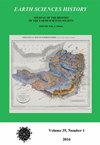绘制basutland:地质学家Gordon Murray stockley和Alexander logie du toit之间的通信(1938-1946)
IF 0.3
4区 哲学
Q4 GEOSCIENCES, MULTIDISCIPLINARY
引用次数: 0
摘要
巴苏托兰是前英国保护国(现莱索托王国),位于马鲁蒂和德拉肯斯堡山脉,被南非包围。关于巴苏托兰的地质知识始于19世纪30年代法国传教士的活动,并在整个19世纪持续积累。系统地质测绘始于1902-1904年,由欧内斯特·施瓦茨和亚历山大·杜托伊特完成,他们在为好望角地质委员会工作期间,将测绘活动扩展到了巴苏托兰。1905年,来自莫里亚的Samuel Dornan开始研究巴苏托兰地区的地质。20世纪30年代,有关钻石发现的传言促使英国政府对该国进行了地质测绘。Gordon Stockley是坦噶尼喀地质调查局的一名经验丰富的地质学家,1938年末被借调到巴苏托兰。1939年,斯托克利在11个月内绘制了整个国家的地图,然后返回坦噶尼喀。他的地质图于1946年出版,比例尺为1:380160,报告于1947年发表。在绘制地图之初,斯托克利写信给杜托伊特,询问他对巴苏托兰地质、地貌和古生物学的各种问题的建议。他们的通信一直持续到1946年。Stockley关于巴苏托兰地质的地图和报告为未来的所有勘探奠定了基础,并在20世纪60年代发现了几个含金刚石金伯利岩管道,并建立了几个钻石矿,为现代莱索托的经济做出了重大贡献。本文章由计算机程序翻译,如有差异,请以英文原文为准。
MAPPING BASUTOLAND: CORRESPONDENCE BETWEEN GEOLOGISTS GORDON MURRAY STOCKLEY AND ALEXANDER LOGIE DU TOIT (1938–1946)
Basutoland is a former British Protectorate (now the Kingdom of Lesotho) nestled in the Maluti and Drakensberg mountains, surrounded by South Africa. Geological knowledge about Basutoland started with the activities of French missionaries in the 1830s and continued to accumulate throughout the nineteenth century. Systematic geological mapping began in 1902–1904 with the work of Ernest Schwarz and Alexander du Toit, who, while working for the Geological Commission of the Cape of Good Hope, extended their mapping activities into Basutoland. In 1905 Samuel Dornan from Morija started studying the geology of that region of Basutoland. In the 1930s rumours about the finds of diamonds prompted the British Government to map the country geologically. Gordon Stockley, a geologist experienced in mapping for the Geological Survey of Tanganyika, was seconded to Basutoland in late 1938. Stockley mapped the whole country in 11 months in 1939, and then returned to Tanganyika. His geological map, at a scale of 1:380,160 was published in 1946, and the report appeared in 1947. At the start of his mapping, Stockley wrote to du Toit asking his advice on various matters related to the geology, geomorphology and palaeontology of Basutoland. Their correspondence lasted until 1946. Stockley’s map and report on Basutoland geology laid the foundation for all future exploration and led to the discovery of several diamondiferous kimberlite pipes in the 1960s, and to the establishment of several diamond mines that contribute significantly to the economy of modern Lesotho.
求助全文
通过发布文献求助,成功后即可免费获取论文全文。
去求助
来源期刊

Earth Sciences History
GEOSCIENCES, MULTIDISCIPLINARY-HISTORY & PHILOSOPHY OF SCIENCE
CiteScore
1.00
自引率
0.00%
发文量
1
审稿时长
>12 weeks
期刊介绍:
Earth Sciences History promotes and publishes historical work on all areas of the earth sciences – including geology, geography, geophysics, oceanography, paleontology, meteorology, and climatology.
The journal honors and encourages a variety of approaches to historical study: biography, history of ideas, social history, and histories of institutions, organizations, and techniques.
Articles are peer reviewed.
 求助内容:
求助内容: 应助结果提醒方式:
应助结果提醒方式:


